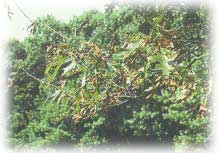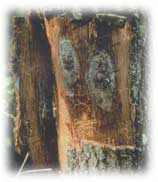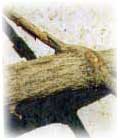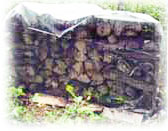

The fungus Ceratocystis fagacearum causes oak wilt. The fungus invades water-conducting vessels and induces the formation of balloon like projections called tyloses, which plug the vessels. As water movement within the tree slows, the leaves wilt and drop off the tree.
Oak species are divided into two groups. Trees in the red oak group (black, northern pin and other oak trees with pointed leaf edges) and white oak group (white, swamp white, bur and other oak trees with rounded leaf edges) are susceptible to oak wilt infection. However, oaks in the red oak group always are killed rapidly by the fungus whereas oaks in the white oak group tolerate the infection better and often survive longer.
Red Oak Group
Trees in the red oak group usually drop their leaves within a three-week period either in late June or throughout July and August. Some lose a portion of their leaves in September, then rapidly lose all their leaves just after they bud in the spring.
White Oak Group
Trees in the white oak group drop their leaves from either one or several branches for several years in a row. These trees do not always die and have a greater chance of surviving infection than red oaks.

Underground
Most oak wilt moves from diseased trees to healthy trees through interconnected roots (root grafts). Root grafts normally form between oaks of the same species; grafts between red and white oaks are rare. It is more likely that root grafts will form between red oaks than white oaks.
Overland
Some oak wilt moves overland via sap-feeding beetles. In the spring, fungal mats (small masses of Ceratocystis fagacearum) develop under the bark of some trees that died from oak wilt the year before. These mats force the bark to crack open. The fungus produces a sweet odor that attracts sap-feeding beetles, which then pick up fungal spores while feeding on the mats. The beetles then fly to healthy oaks to feed on sap flowing from fresh wounds, thus infecting healthy trees. Overland spread can also occur when firewood or logs from infected trees harboring fungal mats are moved.
Collect three twigs (about 1/2-inch in diameter and 4-inch in length) from three different branches with wilting leaves. Samples must still have live tissue. Scratch the sample branch with your fingernail. If the wood under the bark is a light color (white to green), the sample is fresh. If the wood is brown or dark, it is too old to sample. Wrap the sample in waxed paper and keep it cool until you mail it. Mail the sample, along with $20 to:
Plant Disease Diagnostics Clinic
Department of Plant Pathology
University of Wisconsin-Madison
1630 Linden Dr.
Madison, WI 53706-1598

Wounding, Timing, Susceptibility
Oak trees are most susceptible to overland spread in the springtime, from bud swelling until two to three weeks past full leaf development.
April 15-July 1. During this highly susceptible period, do not prune, cut or injure oaks! If an oak is wounded during this time, cover the wound immediately with tree wound paint. Tree wound paint does not help wound closure process, but does act as a barrier to the fungus. Limit the use of wound paint ONLY to the time period described above.
Overland infection can occur after July 1, so to take a cautious approach, do not prune or wound oaks from April 15-October 31.
Management Through Disruption of Common Root Systems
Spread of oak wilt through grafted root systems is the most common way oak trees become infected. If healthy oaks of the same species are near an infected tree, removing the infected tree will not control the spread. In fact, the movement of the fungus through the root grafts may hasten after the prompt removal of infected trees. The best control measure is to install root graft barriers, which disrupt the common root systems between healthy and diseased trees. The most successful methods to install root graft barriers involve physically severing roots with a vibratory or cable plow or trencher. Barriers must be created in the correct location for success. Often, adjacent oaks that appear healthy may already be infected, but have yet to show symptoms. A forest pest specialist, forester or consultant trained in oak wilt management should work with you to find a barrier location.
Management Through Use of Injected Fungicides
Fungicide applications – macro infusions of Alamo™ fungicide into the tree trunk have been shown to offer up to three years of protection against oak wilt in red oaks and can be used therapeutically in the white oak group.

After installing root graft barriers, diseased wood may be removed and used for firewood or other wood products. Trees that have died from oak wilt can harbor fungal mats, so if this wood is moved, the fungal mats are moved as well and the disease may spread to areas currently unaffected. Any trees that have died from oak wilt and have bark that is tightly attached to the wood could harbor fungal mats. This wood must receive special treatment. Once that bark is loose and falls off the wood, the mats are no longer viable and no special treatment is necessary; movement of the wood is no longer a concern.
Firewood
Two methods of wood treatment are effective in preventing overland spread via firewood:
Other Wood Products
Wood from infected trees may be sold to a sawmill or chipping facility - preferably one which is several miles away from the nearest red oak. Advise the purchaser that the infected trees with tightly attached bark must be utilized over the coming winter.
The oak wilt fungal mat does not survive well when it is dried out, exposed to other adverse conditions, or put in competition with other wood decay fungi. Thus, wood chips from infected trees are highly unlikely to serve as a source of disease inoculum or spores, and can be used for landscaping.
UW-Extension recommendations are to disinfect pruning tools between cuts with 70% isopropyl alcohol (rubbing alcohol) or a solution of 10% bleach.
If you allow the disease to progress, it will spread to healthy oaks that are grafted through roots to the diseased trees. In stands where oak is common and root grafting prevalent, an ever-widening pocket of dead oaks will form. In forests where oak is mixed with other species and is a minor component, spread will be slower and may actually stop from a lack of root grafting. New pockets may also form via overland spread by sap-feeding beetles.
Dead oak trees can serve as excellent den trees for wildlife. Oaks do not decay as quickly as aspen, birch and red maple, thus will provide shelter for wildlife for many years. Also, as oaks die, the site often becomes brushy for about ten years. The brushy area will attract warblers, grosbeaks, cuckoos, cardinals, grouse, rabbits, deer and shrews. Brown creepers may nest under the sloughing bark on dead trees. Dead trees will also furnish insects for birds, and larger specimens may provide perches for raptors.